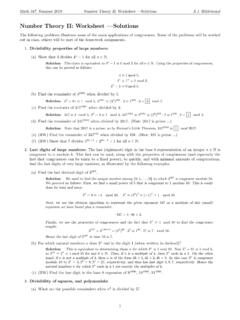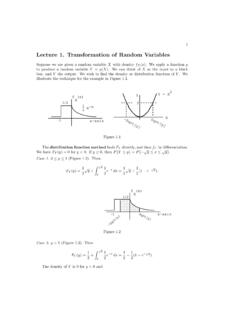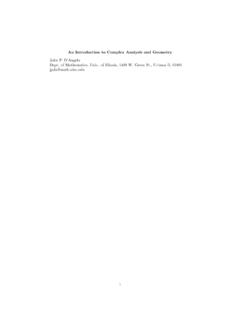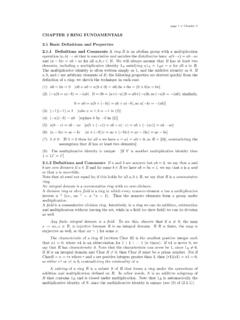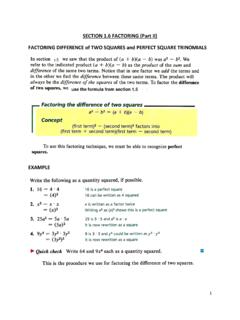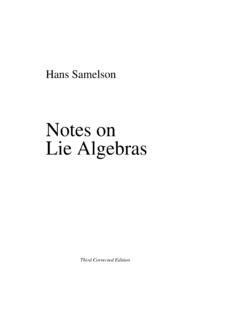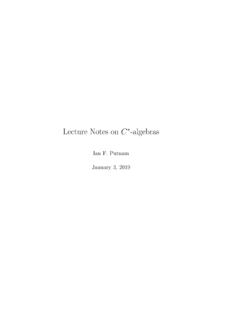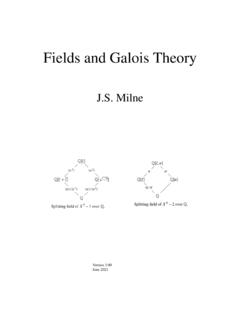Transcription of Module Fundamentals
1 Chapter 4 Module Modules and Definitions and CommentsA vector spaceMover a fieldRis a set of objects called vectors, which can be added,subtracted and multiplied by scalars (members of the underlying field). ThusMis anabelian group under addition, and for eachr Randx Mwe have an elementrx multiplication is distributive and associative, and the multiplicative identity of thefield acts as an identity on vectors. Formally,r(x+y)=rx+ry;(r+s)x=rx+sx;r(sx) =(rs)x;1x=xfor allx,y Mandr,s R. A Module is just a vector space over a ring. The formaldefinition is exactly as above, but we relax the requirement thatRbe a field, and insteadallow an arbitrary ring. We have written the productrxwith the scalarron the left, andtechnically we get aleftR-moduleover the ringR. The axioms of arightR-moduleare(x+y)r=xr+yr;x(r+s)=xr+ xs;(xs)r=x(sr),x1=x.
2 Module will always mean left Module unless stated otherwise. Most of the time, thereis no reason to switch the scalars from one side to the other (especially if the underlyingring is commutative). But there are cases where we must be very careful to distinguishbetween left and right modules (see Example 6 of ( )). Some Basic Properties o fModulesLetMbe anR- Module . The technique given for rings in ( ) can be applied to establishthe following results, which hold for anyx Mandr R. We distinguish the zero vector0 Mfrom the zero scalar 0R.(1)r0M=0M[r0M=r(0M+0M)=r0M+r0M](2) 0Rx=0M[0Rx=(0R+0R)x=0Rx+0Rx] (3) ( r)x=r( x)= (rx) [as in (2) of ( ) withareplaced byrandbbyx](4) IfRis a field, or more generally a division ring, thenrx=0 Mimplies that eitherr=0 Rorx=0M. [Ifr = 0, multiply the equationrx=0 Mbyr 1.]
3 ] Examples1. IfMis a vector space over the fieldR, thenMis Any ringRis a Module over itself. Rather than check all the formal requirements,think intuitively: Elements of a ring can be added and subtracted, and we cancertainly multiplyr Rbyx R, and the usual rules of arithmetic IfRis any ring, thenRn, the set of alln-tuples with components inR,isanR- Module , with the usual definitions of addition and scalar multiplication (as inEuclidean space, ,r(x1,..,xn)=(rx1,..,rxn), etc).4. LetM=Mmn(R) be the set of allm nmatrices with entries inR. ThenMisanR- Module , where addition is ordinary matrix addition, and multiplication of thescalarcby the matrixAmeans multiplication of each entry Every abelian groupAis aZ- Module . Addition and subtraction is carried outaccording to the group structure ofA; the key point is that we can multiplyx Aby the >0, thennx=x+x+ +x(ntimes); ifn<0, thennx= x x x(|n|times).
4 In all of these examples, we can switch from left to right modules by a simple notationalchange. This is definitely not the case in the next LetIbe a left ideal of the ringR; thenIis a leftR- Module . (Ifx Iandr Rthenrx(but not necessarilyxr) belongs toI.) Similarly, a right ideal is a rightR- Module , and a two-sided ideal is both a left and a addition of vectors and scalar multiplication. If multiplica-tion of vectors is allowed, we have Definitions and CommentsLetRbe a commutative ring. We say thatMis analgebra overR, or thatMis anR- algebra ,ifMis anR- Module that is also a ring (not necessarily commutative), and thering and Module operations are compatible, ,r(xy)=(rx)y=x(ry) for allx,y Mandr Examples1. Every commutative ringRis an algebra over itself (see Example 2 of ( )).2. An arbitrary ringRis always aZ- algebra (see Example 5 of ( )).
5 IfRis a commutative ring, thenMn(R), the set of alln nmatrices with entriesinR,isanR- algebra (see Example 4 of ( )).4. IfRis a commutative ring, then the polynomial ringR[X]isanR- algebra , asis the ringR[[X]] of formal power series; see Examples 5 and 6 of ( ). Thecompatibility condition is satisfied because an element ofRcan be regarded as apolynomial of degree IfE/Fis a field extension, thenEis an algebra overF. This continues to hold ifEis a division ring, and in this case we say thatEis adivision check that a subsetSof a vector space is a subspace, we verify thatSis closedunder addition of vectors and multiplication of a vector by a scalar. Exactly the sameidea applies to modules and Definitions and CommentsIfNis a nonempty subset of theR-moduleM, we say thatNis asubmoduleofM(notationN M) if for everyx,y Nandr,s R, we haverx+sy anR- algebra , we say thatNis asubalgebraifNis a submodule that is also a example, ifAis an abelian group (=Z- Module ), the submodules ofAare thesubsets closed under addition and multiplication by an integer (which amounts to additionalso).
6 Thus the submodules ofAare simply the subgroups. IfRis a ring, hence amodule over itself, the submodules are those subsets closed under addition and also undermultiplication by anyr R, in other words, the left ideals. (If we takeRto be a rightR- Module , then the submodules are the right ideals.)We can produce many examples of subspaces of vector spaces by considering kernelsand images of linear transformations. A similar idea applies to Definitions and CommentsLetMandNbeR-modules. Amodule homomorphism(also called anR-homomorphism)fromMtoNis a mapf:M Nsuch thatf(rx+sy)=rf(x)+sf(y) for allx,y Mandr,s ,f(x+y)=f(x)+f(y) andf(rx)=rf(x) for allx,y Mandr a homomorphismfis kerf={x M:f(x)=0}, and theimageoffis{f(x):x M}.If follows from the definitions that the kernel offis a submodule ofM, and the imageoffis a submodule , analgebra homomorphismorhomomorphism of algebrasfromMtoNis anR- Module homomorphism that is also a ring Another Way to Describe an AlgebraAssume thatAis an algebra over the commutative ringR, and consider the mapr r1ofRintoA.
7 The commutativity ofRand the compatibility of the ring and imply that the map is a ring homomorphism. To see this, note that ifr,s Rthen(rs)1 = (sr)1 =s(r1) =s[(r1)1] = (r1)(s1).Furthermore, ify Athen(r1)y=r(1y)=r(y1) =y(r1)so thatr1 belongs to thecenterofA, , the set of elements that commute with , iffis a ring homomorphism from the commutative ringRto the centerof the ringA, we can makeAinto anR- Module viarx=f(r)x. The compatibilityconditions are satisfied becauser(xy)=f(r)(xy)=(f(r)x)y=(rx)yand( f(r)x)y=(xf(r))y=x(f(r)y)=x(ry).Because of this result, the definition of anR- algebra is sometimes given as follows. TheringAis an algebra over the commutative ringRif there exists a ring homomorphism ofRinto the center ofA. For us at this stage, such a definition would be a severe overdoseof : We will often write the Module {0}(and the ideal{0}ina ring) simply as For Section IfIis an ideal of the ringR, show how to make the quotient ringR/Iinto a leftR- Module , and also show how to makeR/Iinto a LetAbe a commutative ring andFa field.
8 Show thatAis an algebra overFif andonly ifAcontains (an isomorphic copy of)Fas a 3, 4 and 5 illustrate that familiar properties of vector spaces need not holdfor Give an example of anR-moduleMwith nonzero elementsr Randx Msuchthatrx= LetMbe the additive group of rational numbers. Show that any two elements ofMare linearly dependent (over the integersZ).5. Continuing Problem 4, show thatMcannot have a basis, that is, a linearly independentspanning set Prove themodular lawfor subgroups of a given groupG: With the group operationwritten multiplicatively,A(B C)=(AB) C. Switching to additive notation, we have, for submodules of a givenR- Module ,A+(B C)=(A+B) C,again ifA LetTbe a linear transformation on the vector spaceVover the fieldF. Show how tomakeVinto anR- Module in a natural way, whereRis the polynomial ringF[X].
9 The Isomorphism Theorems For ModulesIfNis a submodule of theR-moduleM(notationN M), then in particularNis anadditive subgroup ofM, and we may form the quotient groupM/Nin the usual factM/Nbecomes anR- Module if we definer(x+N)=rx+N. (This makes sensebecause ifxbelongs to the submoduleN,sodoesrx.) Since scalar multiplication in thequotient moduleM/Nis carried out via scalar multiplication in the original moduleM,we can check the Module axioms without difficulty. The canonical map :M M/Nisa Module homomorphism with kernelN. Just as with groups and rings, we can establishthe basic isomorphism theorems for Factor Theorem For ModulesAny Module homomorphismf:M M whose kernel containsNcan be factored throughM/N. In other words, there is a unique Module homomorphismf:M/N M such thatf(x+N)=f(x).
10 Furthermore, (i)fis an epimorphism if and only iffis an epimorphism;(ii)fis a monomorphism if and only if kerf=N; (iii)fis an isomorphism if and onlyiffis a epimorphism and kerf= as in ( ), with appropriate notational changes. (In Figure , replaceRbyM,SbyM andIbyN.) First Isomorphism Theorem For ModulesIff:M M is a Module homomorphism with kernelN, then the image offis isomor-phic the factor theorem, and note thatfis an epimorphism onto its image. Second Isomorphism Theorem For ModulesLetSandTbe submodules ofM, and letS+T={x+y:x S,y T}. ThenS+TandS Tare submodules ofMand(S+T)/T =S/(S T). Module axioms forS+TandS Tcan be checked in routine fashion. Definea mapf:S M/Tbyf(x)=x+T. Thenfis a Module homomorphism whose kernelisS Tand whose image is{x+T:x S}=(S+T)/T. The first isomorphism theoremfor modules gives the desired result.




